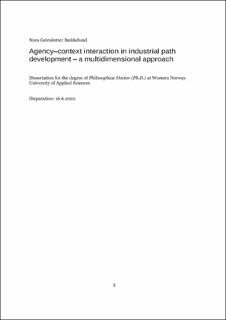| dc.contributor.advisor | Jakobsen, Stig Erik | |
| dc.contributor.advisor | Njøs, Rune | |
| dc.contributor.author | Bækkelund, Nora Geirsdotter | |
| dc.date.accessioned | 2022-06-14T09:15:45Z | |
| dc.date.available | 2022-06-14T09:15:45Z | |
| dc.date.created | 2022-06-13T12:26:19Z | |
| dc.date.issued | 2022 | |
| dc.identifier.citation | Bækkelund, N. G. (2022). Agency–context interaction in industrial path development – a multidimensional approach [Doctoral dissertation]. Western Norway University of Applied Sciences. | en_US |
| dc.identifier.isbn | 978-82-93677-95-6 | |
| dc.identifier.uri | https://hdl.handle.net/11250/2998648 | |
| dc.description.abstract | This dissertation investigates agency in industry path development, and how it interacts with context. A multidimensional approach to agency–context interaction is developed and used to understand both the ability of people to act, and the effects of their actions. The literature has long recognized the interaction between agency and context; this dissertation takes this further by exploring how this interaction plays out. Agency–context interaction is understood through five interconnected dimensions: industrial, scalar, institutional, temporal and relational. The industrial, scalar and institutional dimensions highlight how agency interacts with different contextual elements, while the temporal and relational dimensions provide an understanding of how this interaction plays out. Although descriptions of all five dimensions exist in the literature, most contributions have focused on one or a few dimensions, and the industrial dimension prevails. Herein, the relational dimension, which is usually implicit, but is used explicitly to strengthen our understanding of people’s ability to act. Thus, to expand and link the path development literature’s perspective on agency, this multidimensional approach integrates insights from relational economic geography and adjacent literatures.
To find out how agency–context interaction plays out, three tourism path development cases in rural Western Norway were investigated. The dissertation is based on three papers, which contribute to answering the research questions by highlighting different dimensions of agency–context interaction in path development. Paper #1 focuses on how the types of agency vary throughout industry path evolution, emphasising the temporal dimension. Paper #2 investigates how actors do institutional work across different geographical scales and social fields to shape established industry path development, thereby highlighting the interconnections between the industrial, institutional and scalar dimensions. Paper #3 takes a micro perspective, investigating how central change agents use skills and knowledge from past experiences in various social fields, thus emphasizing the relational dimension. Together, these three papers advance our understanding of both people’s ability to act and the effects of their actions.
Abstracting from the three cases, the dissertation shows that agency in industry development is enacted by multiple actors. It also finds that actors’ ability to act is shaped by the relations they have. Central actors in the three cases used skills, knowledge and networks from past experiences in different social fields, as they worked towards industry development. Industry path development is also enabled by local and non-local connections. Furthermore, the space for agency varies as contextual conditions change over time, while the characteristics of agency vary throughout industry path evolution, both in terms of type of action and of how change-oriented it is. Thus, the dissertation provides theoretical insights that are generally relevant to understanding agency in industry path development, expanding the path development literature’s understanding through a multidimensional approach. | en_US |
| dc.language.iso | eng | en_US |
| dc.publisher | Høgskulen på Vestlandet | en_US |
| dc.relation.haspart | Bækkelund, N. G. (2021). Change agency and reproductive agency in the course of industrial path evolution. Regional Studies, 55(4), 757-768. https://doi.org/10.1080/00343404.2021.1893291 | en_US |
| dc.relation.haspart | Bækkelund, N. G. (2022). Fields of change? Actors, institutions and social fields in the green restructuring of the Flåm tourism industry. Growth and Change, 53(2), 848-867. https://doi.org/10.1111/grow.12611 | en_US |
| dc.relation.haspart | Bækkelund, N. G., Jakobsen, S. E., & Njøs, R. (2022). The relatedness of knowledge combinations—a micro perspective. Manuscript submitted for publication. | en_US |
| dc.title | Agency–context interaction in industrial path development – a multidimensional approach | en_US |
| dc.type | Doctoral thesis | en_US |
| dc.description.version | publishedVersion | en_US |
| dc.rights.holder | © copyright Nora Geirsdotter Bækkelund | en_US |
| dc.source.pagenumber | 177 | en_US |
| dc.identifier.cristin | 2031384 | |
| cristin.ispublished | true | |
| cristin.fulltext | original | |
